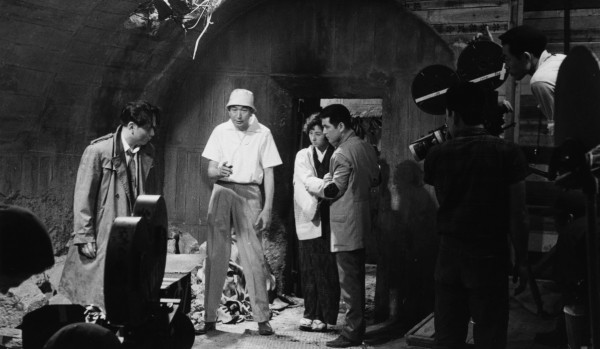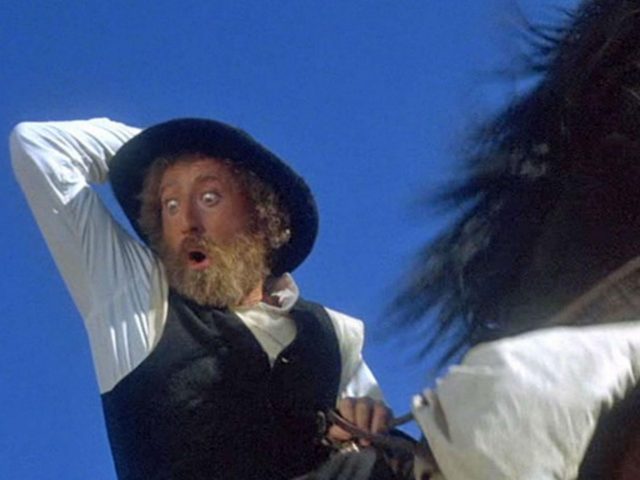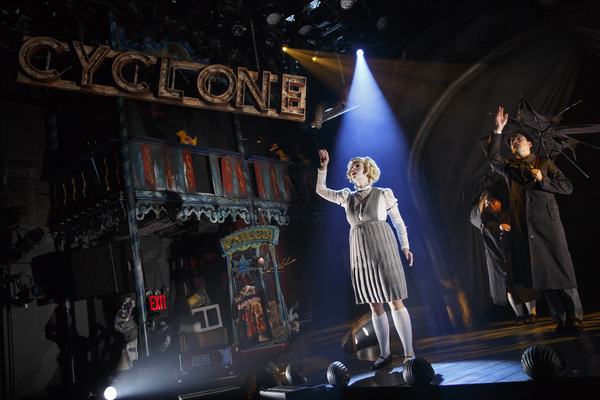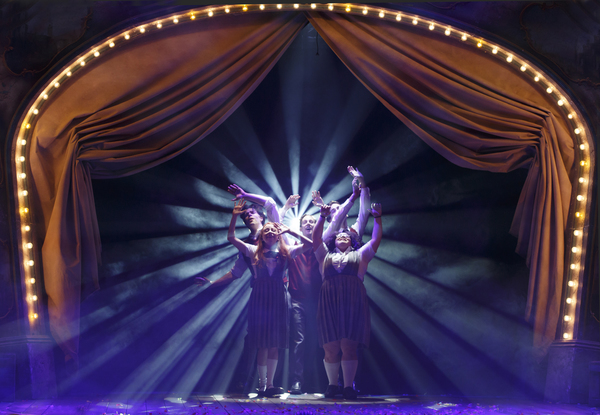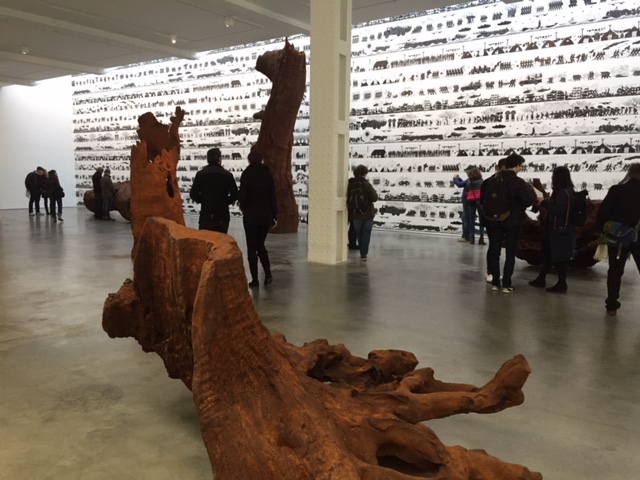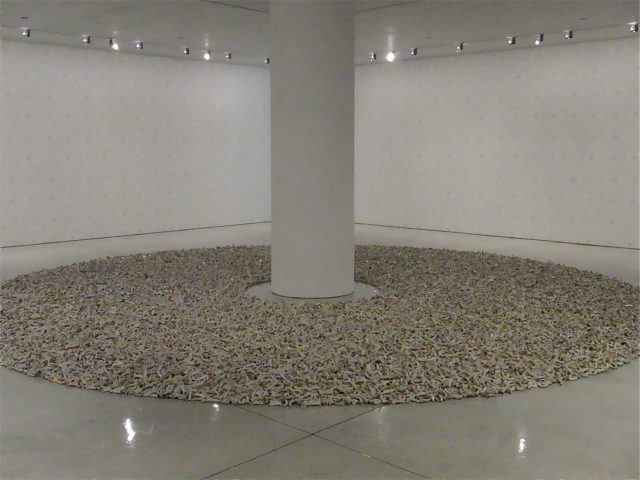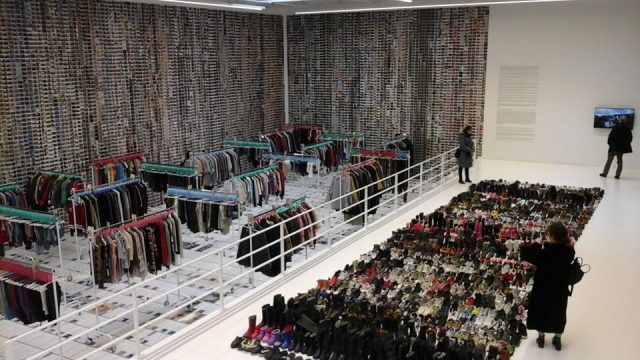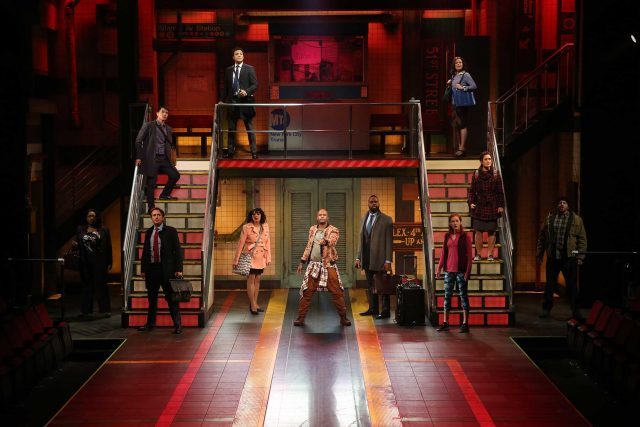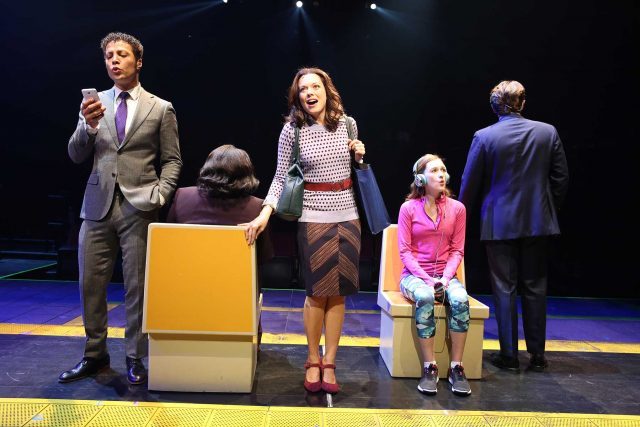
Paul Hackett’s (Griffin Dunne) nightmare starts innocently enough while reading Henry Miller’s TROPIC OF CANCER in a coffee shop in AFTER HOURS
AFTER HOURS (Martin Scorsese, 1985)
Film Society of Lincoln Center, Walter Reade Theater
165 West 65th St. at Amsterdam Ave.
Sunday, December 25, 6:00, and Monday, January 2, 9:15
Series runs through January 3
212-875-5601
www.filmlinc.org
 “We are all alone here and we are dead,” Henry Miller writes in the first paragraph of Tropic of Cancer, which is the book narcissistic word processor Paul Hackett (Griffin Dunne) is reading in a New York City coffee shop, catapulting him into a harrowing downtown nightmare in Martin Scorsese’s brilliant horror comedy, After Hours. Dunne, in one of his two best roles — the other was in John Landis’s very different horror comedy, 1981’s An American Werewolf in London — is exceptional as Hackett, a stand-in for the proverbial everyman seeking safety and home but bedeviled by circumstance, again and again and again. At the coffee shop, Hackett meets charming but unpredictable Marcy Franklin (Roseanna Arquette), who invites him over to her friend’s loft in SoHo. It’s already late, but the titillated Upper East Sider decides to takes a cab downtown; however, the last of his money, a twenty-dollar bill, literally flies out the window as his taxi driver (Larry Block) speeds like a madman through the mean streets of Manhattan. These eighties days predate ATMs, cashback, and Ubers, and Hackett spends the rest of his very long night encountering a bizarre cast of characters, none of whom seems able to give him the fifty-three cents he needs to cover the new subway fare of $1.50, which rose suddenly at midnight, plunging him into after-hours chaos. Among those he meets are kinky sculptor Kiki Bridges (Linda Fiorentino) and her sadist lover, Horst (Will Patton); lonely cocktail waitress and sixties leftover Julie (Teri Garr); helpful bartender Tom (John Heard); possible thieves Neil (Cheech Marin) and Pepe (Tommy Chong); ice-cream-truck driver Gail (Catherine O’Hara); and lonely lady June (Verna Bloom). Not the best judge of character, at least partly because he’s not exactly a sympathetic listener, the Yuppie-ish Hackett is soon running through the streets of SoHo in the rain, chased by an angry vigilante mob.
“We are all alone here and we are dead,” Henry Miller writes in the first paragraph of Tropic of Cancer, which is the book narcissistic word processor Paul Hackett (Griffin Dunne) is reading in a New York City coffee shop, catapulting him into a harrowing downtown nightmare in Martin Scorsese’s brilliant horror comedy, After Hours. Dunne, in one of his two best roles — the other was in John Landis’s very different horror comedy, 1981’s An American Werewolf in London — is exceptional as Hackett, a stand-in for the proverbial everyman seeking safety and home but bedeviled by circumstance, again and again and again. At the coffee shop, Hackett meets charming but unpredictable Marcy Franklin (Roseanna Arquette), who invites him over to her friend’s loft in SoHo. It’s already late, but the titillated Upper East Sider decides to takes a cab downtown; however, the last of his money, a twenty-dollar bill, literally flies out the window as his taxi driver (Larry Block) speeds like a madman through the mean streets of Manhattan. These eighties days predate ATMs, cashback, and Ubers, and Hackett spends the rest of his very long night encountering a bizarre cast of characters, none of whom seems able to give him the fifty-three cents he needs to cover the new subway fare of $1.50, which rose suddenly at midnight, plunging him into after-hours chaos. Among those he meets are kinky sculptor Kiki Bridges (Linda Fiorentino) and her sadist lover, Horst (Will Patton); lonely cocktail waitress and sixties leftover Julie (Teri Garr); helpful bartender Tom (John Heard); possible thieves Neil (Cheech Marin) and Pepe (Tommy Chong); ice-cream-truck driver Gail (Catherine O’Hara); and lonely lady June (Verna Bloom). Not the best judge of character, at least partly because he’s not exactly a sympathetic listener, the Yuppie-ish Hackett is soon running through the streets of SoHo in the rain, chased by an angry vigilante mob.
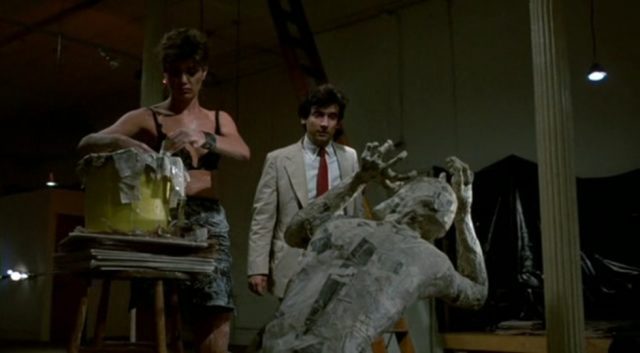
Paul Hackett (Griffin Dunne) has plenty to scream about after meeting sculptor Kiki Bridges (Linda Fiorentino) in Martin Scorsese’s brilliant black comedy
Written as a film-school project by Joseph Minion and inspired by Joe Frank’s monologue “Lies” (which led to a plagiarism battle), After Hours is shot in a modern noir style by regular Scorsese cinematographer Michael Ballhaus (Goodfellas, The Last Temptation of Christ, The Departed). Much of the film takes place in dark rooms and spaces; at one point, inside the S&M Berlin Club, Scorsese himself, in a cameo as a stage tech, shines a spotlight right into the camera, temporarily blinding the viewer. The many dichotomies in the film range from light and dark to uptown/downtown to fire and water; there are multiple references to fire and burns, as if Paul is trapped in a kind of hell, and it is often raining as he tries to find a way out. Paul’s metaphorical impotency is also a major theme; he keeps meeting women who are sexually attracted to him, but just as he can’t get north of SoHo, he has no luck in various bedrooms, for various reasons. In a bathroom, he sees a drawing of a shark chomping on an erect penis, and it’s no coincidence that Gail drives a Mr. Softee truck. The film also features cameos by character actors Clarence Felder as a bouncer, Dick Miller, Rocco Sisto, and Victor Argo as diner and coffee-shop employees, and Bronson Pinchot as Paul’s ambitious coworker, while the fab score ranges from Mozart and Bach to Joni Mitchell, the Monkees, Bad Brains, and Peggy Lee. A ferocious, fast-paced fantasia about abject loneliness, pretentious art, and the ever-present prospect of death, After Hours is screening December 25 and January 2 at the Walter Reade Theater as part of the Film Society of Lincoln Center series “Going Steadi: 40 Years of Steadicam,” which consists of twenty-nine films that feature the use of the Steadicam, invented by Garrett Brown and first used in 1976 in Hal Ashby’s Bound for Glory; the Steadicam operator for After Hours was one of the masters, Larry McConkey (Goodfellas, The Silence of the Lambs, Kill Bill). The series runs through January 3 and also includes Goodfellas, Quentin Tarantino’s Pulp Fiction and Jackie Brown, Stanley Kubrick’s Eyes Wide Shut and The Shining, Warren Beatty’s Bulworth, Bertrand Tavernier’s Coup de Torchon, Gus Van Sant’s Elephant, and Paul Thomas Anderson’s Boogie Nights and Magnolia.
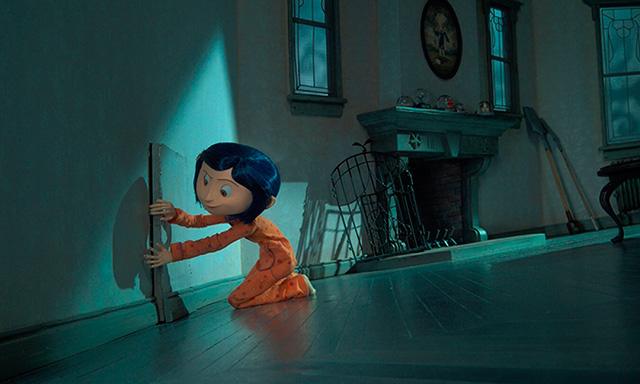
 Coraline Jones (voiced by Dakota Fanning) is an adventurous eleven-year-old in search of some fun and excitement in her new creaky home in Oregon. She finds just what she thinks she was looking for when a rodent introduces her to a hidden passageway that leads to an alternate universe, where replicas of her parents (Teri Hatcher and John Hodgman) are more interested in her and give her whatever she wants. However, this button-eyed Other Mother and Other Father have other plans for her and her real family as well. Written and directed by Henry Selick, Coraline lacks the frantic, nonstop energy of his breakthrough film, Tim Burton’s The Nightmare Before Christmas, but it is still a fun, creepy trip down the Narnia-esque rabbit hole. Combining his trademark stop-motion animation (James and the Giant Peach) with breathtaking stereoscopic 3-D that adds remarkable depth to the images, Selick does a marvelous job bringing to life the popular children’s novel by Newbery Medal–winning author Neil Gaiman (Sandman), who wrote the book for his young daughters. (Full disclosure: In another part of our life, we work for the company that publishes Gaiman’s children’s books, including Coraline.) The supporting cast of characters includes former music-hall divas Miss Spink and Miss Forcible (the Absolutely Fabulous British comedy team of Jennifer Saunders and Dawn French), the wise Cat (Keith David), mouse circus leader Mr. Bobinsky (Ian McShane), and local boy Wybie Lovat (Robert Bailey Jr.), who was created specifically for the movie. Be sure to stick around for one last cool 3-D effect at the end of the credits. Coraline is screening on Christmas Eve and Christmas Day at 12 noon, concluding the Metrograph series “From Coraline to Kubo: The Magic of LAIKA,” consisting of four 3-D films featuring animation by LAIKA studios in Oregon.
Coraline Jones (voiced by Dakota Fanning) is an adventurous eleven-year-old in search of some fun and excitement in her new creaky home in Oregon. She finds just what she thinks she was looking for when a rodent introduces her to a hidden passageway that leads to an alternate universe, where replicas of her parents (Teri Hatcher and John Hodgman) are more interested in her and give her whatever she wants. However, this button-eyed Other Mother and Other Father have other plans for her and her real family as well. Written and directed by Henry Selick, Coraline lacks the frantic, nonstop energy of his breakthrough film, Tim Burton’s The Nightmare Before Christmas, but it is still a fun, creepy trip down the Narnia-esque rabbit hole. Combining his trademark stop-motion animation (James and the Giant Peach) with breathtaking stereoscopic 3-D that adds remarkable depth to the images, Selick does a marvelous job bringing to life the popular children’s novel by Newbery Medal–winning author Neil Gaiman (Sandman), who wrote the book for his young daughters. (Full disclosure: In another part of our life, we work for the company that publishes Gaiman’s children’s books, including Coraline.) The supporting cast of characters includes former music-hall divas Miss Spink and Miss Forcible (the Absolutely Fabulous British comedy team of Jennifer Saunders and Dawn French), the wise Cat (Keith David), mouse circus leader Mr. Bobinsky (Ian McShane), and local boy Wybie Lovat (Robert Bailey Jr.), who was created specifically for the movie. Be sure to stick around for one last cool 3-D effect at the end of the credits. Coraline is screening on Christmas Eve and Christmas Day at 12 noon, concluding the Metrograph series “From Coraline to Kubo: The Magic of LAIKA,” consisting of four 3-D films featuring animation by LAIKA studios in Oregon.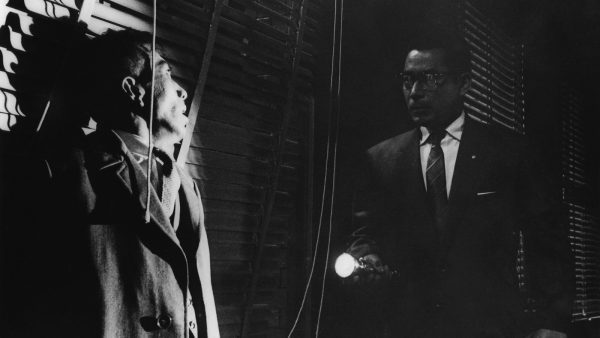
 IFC Center’s eleven-film Weekend Classics series “Kurosawa & Mifune” comes to a close Christmas weekend with one of the pair’s underseen best, the Shakespearean noir, The Bad Sleep Well. The twelfth of sixteen films director Akira Kurosawa and actor Toshirô Mifune made together between 1948 and 1965, The Bad Sleep Well is a tense, gripping thriller in which Kurosawa takes on post-WWII Japanese corporate culture, incorporating elements of Hamlet into the complex narrative. The 1960 film begins with a long wedding scene in which everything is set in motion, from identifying characters (and their flaws) to developing the central storylines. Kōichi Nishi (Mifune) is marrying Yoshiko (Kyōko Kagawa), a young woman with a physical disability whose father is Iwabuchi (Masayuki Mori), the vice president of Public Corporation, a construction company immersed in financial scandal as related by one of the many cynical reporters (Kōji Mitsui) covering the party and anticipating possible arrests. Also at the affair are Iwabuchi’s cohorts in crime, Miura (Gen Shimizu), Moriyama (Takashi Shimura), Shirai (Kō Nishimura), and Wada (Kamatari Fujiwara), as well as Iwabuchi’s rogue son, Tatsuo (Tatsuya Mihashi), who threatens to kill Nishi if he does anything to hurt his sister. It soon becomes clear that Nishi in fact does have more on his mind than just marrying into the company. “Even now they sleep soundly, grins on their faces,” Nishi declares. “I won’t stand for it! I can never hate them enough!”
IFC Center’s eleven-film Weekend Classics series “Kurosawa & Mifune” comes to a close Christmas weekend with one of the pair’s underseen best, the Shakespearean noir, The Bad Sleep Well. The twelfth of sixteen films director Akira Kurosawa and actor Toshirô Mifune made together between 1948 and 1965, The Bad Sleep Well is a tense, gripping thriller in which Kurosawa takes on post-WWII Japanese corporate culture, incorporating elements of Hamlet into the complex narrative. The 1960 film begins with a long wedding scene in which everything is set in motion, from identifying characters (and their flaws) to developing the central storylines. Kōichi Nishi (Mifune) is marrying Yoshiko (Kyōko Kagawa), a young woman with a physical disability whose father is Iwabuchi (Masayuki Mori), the vice president of Public Corporation, a construction company immersed in financial scandal as related by one of the many cynical reporters (Kōji Mitsui) covering the party and anticipating possible arrests. Also at the affair are Iwabuchi’s cohorts in crime, Miura (Gen Shimizu), Moriyama (Takashi Shimura), Shirai (Kō Nishimura), and Wada (Kamatari Fujiwara), as well as Iwabuchi’s rogue son, Tatsuo (Tatsuya Mihashi), who threatens to kill Nishi if he does anything to hurt his sister. It soon becomes clear that Nishi in fact does have more on his mind than just marrying into the company. “Even now they sleep soundly, grins on their faces,” Nishi declares. “I won’t stand for it! I can never hate them enough!”